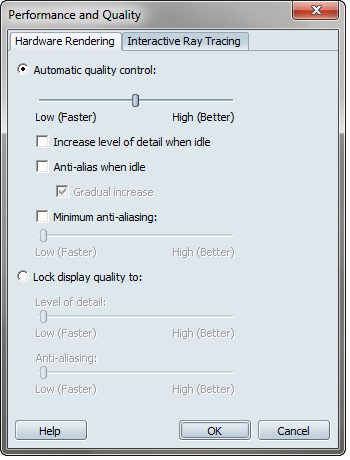Optimize Hardware with the Performance and Quality dialog box
Click File > Preferences > Performance and Quality to open the Performance and Quality dialog box:

In the Hardware Rendering tab, use the Automatic quality control slider to set the emphasis you want to place on visual quality. Showcase will adjust frame rate to maintain visual quality as best as possible according to your choice. It does this by using the LODs defined in the currently selected LOD script (see Adjust import conversion settings). Move the slider toward Low if you are lacking in system resources or only viewing objects from a distance. Move it toward High if you have a very fast system or if you are doing close-ups with many details.
Autodesk recommends leaving the slider in the center (the default) and only changing it if you notice reduced visual quality. If your current LOD setting includes only one level, moving the slider has no effect.
Increase level of detail when idle
Select Increase level of detail when idle to let Showcase improve visual quality to the highest possible LOD when idle.
Anti-aliasing is a smoothing calculation that builds up the look of surfaces, materials and textures. Select the anti-aliasing options to give surfaces a more realistic appearance, but be aware that frame rate may be affected.
To verify the number of levels of detail (LOD) after you load a model, select Lock display quality to, and move the slider back and forth to see the different LODs. You might want to lock the display quality to low if you just want the system to work fast and efficiently while you are working on a scene. Or perhaps your working computer is not as powerful as the one on which you will be doing your presentation, so you lock LOD to low when you are working.
If an object in your scene warrants an exception to these performance and quality settings, right-click it and select Importance/Priority > Low Priority, Medium Priority, or High Priority.
For example, if you have set the automatic slider to Low but a particular object has to look good, set its priority to High. Or, if you have many objects in the background with many polygons, such as trees, set them to Low so that they do not have a big impact on performance. Similarly, imagine a model from Autodesk Inventor that includes many screws, each of which uses a lot of memory. You can select all screws using the Organizer and set them to Low to improve performance.
Under Lock display quality to, use the Anti-aliasing slider to lock Showcase to an anti-aliasing level. Lower anti-aliasing provides better performance, while higher anti-aliasing may slow performance.